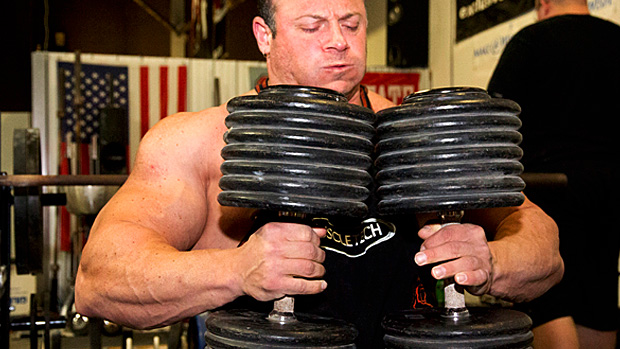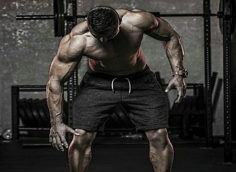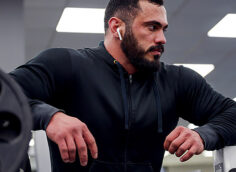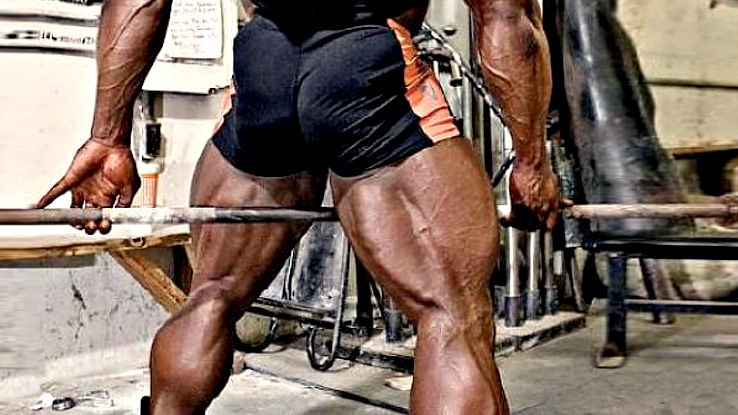The bench press is the king of upper body exercises. It's the most revered measure of a young lifter's weight lifting acumen and will add slabs of beef to the pecs, shoulders, and triceps few exercises can match.
Not surprisingly, the bench press has achieved near-mythic status in most gyms, so much so that there's no doubt a bill currently before Congress proposing Monday be officially renamed Bench Press Day.
So why do so many lifters possess tiny bird chests and a bench press max that matches their IQ score?
Performing the bench press correctly makes all the difference. Not just using correct form, but also proper weight selection, intelligent programming, appropriate assistance exercises, and understanding technique will all make or break bench press success.
Form/Technique
It all starts with a proper setup. Your set up and technique depends upon whether your primary goal is to move the most weight or build the biggest chest. The big difference between the two is the use of the arch. Powerlifters want to maximize their arch as it decreases the range of motion while increasing leverage, allowing more weight to be moved. Bodybuilders want less of an arch so that the muscle is worked through a greater range of motion.
Setup and Foot Placement
I'll cover the powerlifting setup first since this is the more complex of the two.
- Lie down on the bench and grab the bar with an underhand grip.
- Slide backwards along the bench and under the bar until your upper ab area is directly under the bar.
- Tuck your feet back under the bench directly beneath the hips, with the balls of the feet in contact with the floor and heels raised.
- Slide or "contract" your body back towards the bottom of the bench until the torso is in the proper position to bench. At this point the lower back should be arched quite high.
- Make sure the hips are in contact with the bench and dig the traps and shoulder blades (which should be pulled back together tight) into the bench. This provides stability under heavy weights and helps decrease the range of motion as it pushes the chest up while pulling the shoulders back.
- Adjust your grip, unrack the bar, and perform your bench press.
For bodybuilders:
- The feet can either be placed underneath the hips as in the description above or flat on the floor in front of you.
- If you have difficulty keeping the hips on the bench while pressing, start with the feet underneath as this still allows a good degree of leg drive but is more conducive to keeping the hips on the bench.
- Lie back and dig the traps into the bench for stability. There's no need for a big arch as you don't want to decrease the range of motion.
Leg Drive
Many lifters are confused by leg drive and how to effectively use it.
- With either foot placement, keep your feet planted firmly against the floor and maintain a moderate amount of tension in the legs as you lower the bar to the chest.
- As the bar touches the chest, reverse direction and push hard with the legs, driving the bar off the chest. This will help "pop" the bar off while the added momentum will assist in getting through the sticking point through lockout.
Bar Path
Correct bar path is another aspect of the bench press many lifters fail to understand.
- The most mechanically efficient bar path is a gradual arc from just below the nipple line at the bottom to roughly above the base of the neck at lockout. The exact points will vary slightly depending on individual leverages.
- To perform this properly, tuck your elbows in towards the sides as you lower the bar, aiming for a point just below the nipple line when the bar is touching the chest.
- The lowering of the bar must be performed in the correct groove as the body will naturally want to follow the same path as you press upward. The concentric and eccentric portions of the bench press should appear as mirror images of each other.
- As you begin to drive the bar from the chest keep the elbows tucked, but as the bar approaches the midpoint gradually rotate the elbows out until they're fully flared at lock out. This should be performed carefully as flaring too fast or too soon will send the bar back over your head and into the racks, stressing the shoulder joint.
Elbow Position
Tucking the elbows at the bottom decreases shoulder rotation and takes stress off the shoulder joint. It also takes pressure off the pec tendon and decreases the chance of a pec tear, allowing more weight to be lifted through improved leverage.
- When the bar is at the chest, the elbows, wrists, and the bar should all be in a perfectly straight line when viewed from the side.
- Do not allow the wrists to bend backward. Not only does this place stress on the wrist, it can negatively affect leverage. In several cases big benchers have broken their arms by using this technique.
Grip
While most lifters realize that using a wider grip will focus more on the chest and that a closer grip targets the triceps, few realize that how you grip the bar affects muscle recruitment. Selecting the appropriate grip ensures you're working with and not against your own strengths and leverages.
- There are three different ways to grip the bar: with a full grip (thumb wrapped all the way around the bar), a false or thumb-less grip (thumb behind the bar), and with the thumb held straight out along the bar.
- Regardless of the grip, always attempt to squeeze the bar hard and push out to the sides as if trying to pull the bar apart. This will help engage the triceps.
- Changing the position of the thumb affects elbow position. The full grip rotates the hand outward to a greater degree, thereby rotating the elbows out and emphasizing the chest.
- With the thumb-less grip the hands are turned in more towards the body, making it easier to tuck the elbows on the descent and recruit the triceps.
- Gripping the bar with the thumb along the bar is a compromise of the two. So a lifter with a comparatively stronger chest (or one looking to work the chest to the highest degree) would benefit from a wide, full grip, whereas a lifter with extremely strong triceps would get the most out of a relatively narrow thumb-less grip.
Assistance Exercises
The lifter's strengths and weaknesses determine the assistance exercises.
Maintaining structural balance helps prevent injury while allowing you to lift the most weight. Identifying your weaknesses in the bench is relatively easy, assuming the problem isn't technique related.
- Difficulty locking out the weight at the top is usually due to a relative weakness in the triceps, whereas difficulty getting the weight moving at the bottom is typically due to a weak chest.
- The bar barely leaving the chest can be attributed to lat weakness, assuming the problem isn't form or ego related. However, if you're unracking the bar and it's stapling you to the bench, odds are that you just aren't being realistic as far as your true strength levels are concerned.

Strengthening Your Lockout
Reverse Band Presses
My favorite exercise for fixing a lockout weakness is reverse band presses. Even though the exercise focuses on the lockout, it still allows you to work through a full range of motion and press the bar in a normal groove. It also teaches pushing the bar from the chest explosively. If you fail to do this, the momentum from the bands will be lost and locking out the weight will be very difficult.
- To set this exercise up, set a dumbbell bench inside the rack.
- Loop a pair of strong bands around the top of a power cage (one on either side) and hook them around the ends of the bar where you'd normally place the collars.
- This set up will typically take approximately 150 pounds off the bar at chest level and next to nothing at lockout, depending on the height of the cage, bench height, and arm length.
Board Presses
Board presses are very effective for fixing your lockout. Depending on your arm length and where exactly the bar stalls, use between 2-5 boards (referring to the thickness) when performing this exercise.
Typically, boards are constructed from 2"x 6" pine boards and are usually nailed, screwed, or glued together to achieve the desired thickness. I've found that making the pressing area about 18" long and having a 6" handle works well.
- To perform this exercise, simply have a partner hold the boards on your chest while benching. If you don't have a partner, the boards can be easily held in place by securing them to your chest with a single knee wrap tied around you.
Strengthening the Bottom Portion of the Press
Technique issues aside, the ability to drive the bar off of the chest largely comes from the pectoral muscles and lats. Since I covered back training in my last article, I'll focus on strengthening the pecs.
- Any exercise that allows you to work through a greater range of motion will typically help improve the "pop" off the chest. Dumbbell benching and the use of a cambered bar are preferred methods.
- Dumbbell benching prevents the lifter from bouncing the bar and allows work through a greater range of motion by allowing the lifter to get a deeper stretch at the bottom of the movement.
- The cambered bar is also referred to as the "MacDonald Bar" in honor of legendary bencher Mike MacDonald. MacDonald once held every bench press world record from the 181-pound class all the way up to 242 pounds. The bar has a 2" camber, allowing the lifter to lower the bar 2" further than with a standard bar.
You must be careful when first using the MacDonald Bar or injury can easily occur due to the increased range of motion. Also, expect the amount of weight you can use with the MacDonald Bar to initially be significantly less than your normal bench, especially if your primary weakness is at the bottom of the lift.
Programming
Effective programming for the bench press requires well-planned progression, prevents overtraining, stimulates hypertrophy, and reinforces proper technique. I've used the following program with clients that are looking to add pounds to their bench press and extra pec mass. It's not uncommon with this program to see a 20-50 pound increase in a lifter's bench press over a 16-week training period.
The key is to start with an accurate max. Often lifters overestimate their max or use a number they were previously capable of. It's essential to use a current true max that's obtained using proper form. Failure to do so will only result in over training and difficulty progressing from week to week.
In plain English, to make the most of this program you better check your ego.
16 Week Weekly Weight Progression
- Week 1: 5 x 10 x 60% (5 sets of 10 reps @ 60%)
- Week 2: 5 x 8 x 65%
- Week 3: 5 x 5 x 70%
- Week 4: 5 x 3 x 75%
- Week 5: 5 x 10 x 60%
- Week 6: 5 x 8 x 70%
- Week 7: 5 x 5 x 75%
- Week 8: 5 x 3 x 80%
- Week 9: 5 x 10 x 60%
- Week 10: 4 x 8 x 75%
- Week 11: 4 x 5 x 80%
- Week 12: 4 x 3 x 85%
- Week 13: 5 x 10 x 60%
- Week 14: 3 x 8 x 80%
- Week 15: 3 x 5 x 85%
- Week 16: 3 x 3 x 90%
Wrap Up
Benching big weight builds crazy strength and upper body mass, and is also just plain fun as hell. The lifters I know that say they don't care about their bench press numbers usually have pecs like deflated balloons and have trouble benching their bodyweight.
Funny how that happens.
Don't fall into this sour grapes negativity trap. Check your ego and learn how to bench correctly, and find out conclusively where you're weak. Then, get to work.
Bench pressing glory is but a mere 16-weeks away!





